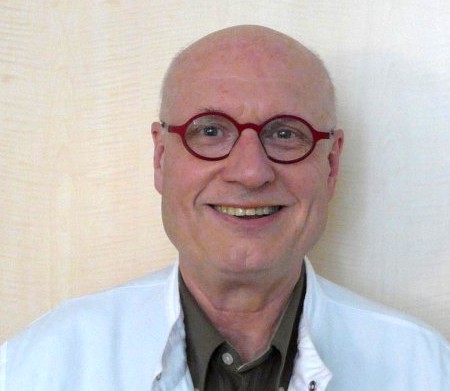Marc Abrahams's Blog, page 217
June 20, 2017
Le Monde celebrates the work of double-Ig-Nobellian Toshi Nakagaki
 Le Monde celebrates the work of two-time Ig Nobel Prize winner Toshi Nakagaki [here auto-translated from French to English]. The report begins:
Le Monde celebrates the work of two-time Ig Nobel Prize winner Toshi Nakagaki [here auto-translated from French to English]. The report begins:
When ‘the blob’ develops according to the Tokyo rail network
In the small community of blob enthusiasts, Toshiyuki Nakagaki is a reference. But his fame goes far beyond that. His work on the unicellular Physarum polycephalum [slime mold] has earned him two IgNobels. Certainly, this award is not worth its prestigious elder. But to win this award – a mixture of incongruity and seriousness – is worth its weight in notoriety. So, twice …
In 2008, the jury first awarded the scientist of the University of Hokkaido for demonstrating that Physarum could emerge from a labyrinth. For an organism without brain or neurons, there was already enough to impress. Two years later, the Japanese biologist made even stronger: he highlighted the incredible ability of the blob to realize effective networks. For this, he reproduced, on a plaque covered with agar gel, the map of the Tokyo area. More precisely, he deposited oatmeal on the thirty-six main localities and installed the unicellular instead of the central station. And he waited….

June 19, 2017
Eggs (spinning) in milk – study
Have you ever wondered why a hard-boiled egg, or a pool ball, spinning on a countertop and passing through a puddle of milk, draws milk up the side of the egg and then ejects it at the maximum radius? So did Ken Langley, Jeff Hendricks, Matthew Elverud, Dan Maynes and Tadd Truscott of Brigham Young University, US.
“
A hard-boiled egg spinning on a countertop and passing through a puddle of milk draws milk up the side of the egg and then ejects it at the maximum radius. This same phenomenon occurs for any partially submerged spinning object whose radius increases upward from the fluid surface (e.g., spheres, inverted cones, rings, etc.). In particular, spheres are used to investigate the behavior of this phenomenon and its sensitivity to experimental parameters. Three modes of ejection — jets, sheets, and sheet break-up — are identified, which are highly dependent on several parameters: viscosity, angular velocity, immersion depth of sphere, and sphere diameter. Experimental results are presented with comparisons to a theoretical model that is derived using integral conservation of momentum. This phenomenon can be used as a pump to easily remove fluids from shallow areas.”
See: ‘Eggs in Milk: The Conclusion’ presented at the 64th Annual Meeting of the APS Division of Fluid Dynamics, Volume 56, Number 18, , 2011. Further details of the investigation, including the photo above, are provided by Tadd Truscott.

June 16, 2017
Do Pimples Pay? Apparently they do (new study)
“We find that the shock of having acne is positively associated with overall grade point average in high school, grades in high-school English, history, math, and science, and the completion of a college degree.“
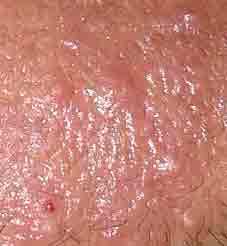 – explain Professor Hugo Mialon (Emory University) and Professor Erik Nesson (Ball State University) who are the authors of a new study which, for the first time, explores the relationship between having acne and subsequent academic and workplace success.
– explain Professor Hugo Mialon (Emory University) and Professor Erik Nesson (Ball State University) who are the authors of a new study which, for the first time, explores the relationship between having acne and subsequent academic and workplace success.
Using data from the National Longitudinal Study of Adolescent to Adult Health (Add Health) , the authors discovered an association – and, having found the association, they go on to speculate that perhaps the ‘decreased socialization’ associated with acne might (somehow) lead to higher educational performance and attainment.
See: ‘Do Pimples Pay? Acne, Human Capital, and the Labor Market’ Emory University Working Paper, May 2017
Also see: Wedding spending and marriage duration, linked? (co-authored by professor Mialon).
Photo (detail): courtesy Roshu Bangal, Wikipedia

June 15, 2017
The Theory That Lesbians Evolved to Please Men [research study]
Researchers in Cyprus gathered info about men’s sexual desire for lesbians. Then, having satisfied their desire to collect that info, the researchers explained what it means to them. The study is:
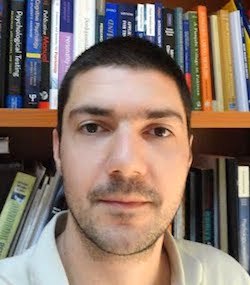 “The evolution of female same-sex attraction: The male choice hypothesis,” Menelaos Apostolou [pictured here], Marios Shialos, Michalis Khalil, and Vana Paschali, Personality and Individual Differences, vol. 116, 2017, pp. 372–378.
“The evolution of female same-sex attraction: The male choice hypothesis,” Menelaos Apostolou [pictured here], Marios Shialos, Michalis Khalil, and Vana Paschali, Personality and Individual Differences, vol. 116, 2017, pp. 372–378.
The authors, at the University of Nicosia, Cyprus, explain: “this paper proposed a theoretical framework where, during the period of human evolution, same-sex attractions in women were under positive selection. The source of positive selection has been male preferences for opposite-sex sex partners who experienced same-sex attractions.”
Apostolou, Shialos, Khalil, and Paschali gathered data: “This theoretical framework was used to generate four predictions that were tested in two online studies which employed a total of 1509 heterosexual participants. ”
Apostolou, Shialos, Khalil, and Paschali explain that the data confirms their expectations about what some men find sexually attractive about some women sometimes:
“It was found that… a considerable proportion of heterosexual men desired partners who experienced same-sex attractions. In addition, it was found that men were more sexually excited than women by the same-sex infidelity of their partners, and they desired more than women, their opposite-sex partners to have sex with same-sex individuals. Finally, participants’ preferences were contingent on the seriousness of the relationships, with same-sex attraction to be preferred more in short-term than in a long-term partner.”
Apostolou, Shialos, Khalil, and Paschali arrive at a new understanding about evolution:
“These findings were employed in understanding the evolutionary origins of same-sex attraction in women…. Men’s desire for women who are attracted to other women selects for women who are attracted to other women. In turn, male desires, along with factors such as arranged marriage, which weakened the negative fitness costs of same-sex attraction, can explain the relatively high frequency of this trait in the population.”
BONUS: The newspaper El País supplies its own interpretation of this study, pointing out that “no homosexual woman has been interviewed in this study.”

Schmutz: White Wine Invites Melanoma, and Coffee Discourages It?
Drinking alcohol — specifically, drinking white wine — may increase your change of getting melanoma, but drinking coffee may decrease your chance. That’s what this new study suggests. The study does not suggest, though we do, that you spend a few minutes exploring the ways that someone might find seemingly interesting things by the process known as “torturing the data.”
Here is the study: “Mélanome: alcool ou café, il faut choisir [Alcohol or coffee to help keep melanoma at bay],” Jean-Luc Schmutz, Annales de Dermatologie et de Vénéréologie, 2017. The author is at Hôpital de Brabois, Vandœuvre-lès-Nancy, France.
Here is Doctor Schmutz:

Brain size in birds and their deaths in traffic accidents? (new study)
If a species of bird has a relatively small brain [compared to other avian species] is it likely to be less intelligent ? And, if so, might it be more likely to be involved in a traffic accident? A team from Ecologie Systématique Evolution, Université Paris-Sud, CNRS, AgroParisTech, Université Paris-Saclay, France and the House of Birdresearch, Taps, Christiansfeld, Denmark, decided to investigate by looking at the number of birds involved in fatal [i.e. for the bird] traffic accidents and comparing the brain sizes of victims :-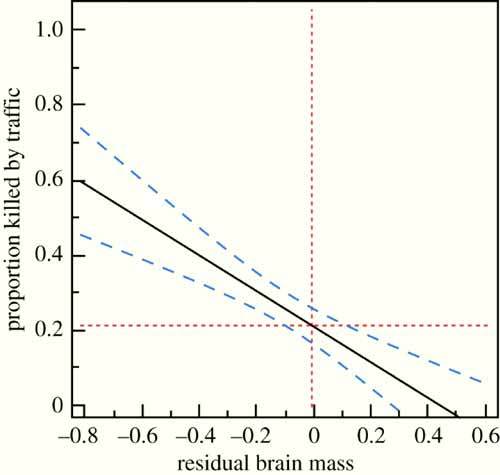
“In conclusion, birds killed by cars have disproportionately small brains for their body size. In contrast, there was no difference in terms of the size of the liver, heart or lungs. Both road kills and birds being shot had disproportionately small brains for their body size. These findings suggest that cognitive differences between dead individuals and survivors may be linked to individual differences in perception and adjustment to movement.”
See: Brain size in birds is related to traffic accidents, Royal Society Open Science, March 2017.
Note. The debate about brain size and intelligence has been going on since Darwin’s time [and probably before]. For a 2017 viewpoint see : Sex differences in brain size and general intelligence (g)
Also see: High-achieving professors’ brains – are they different (to low-achieving professors’)?

June 14, 2017
The further adventures of Erwin Kompanje: Two-headed dolphin
A two-headed dolphin was rescued — rescued in the sense that the world now knows about it in some scientific detail — by Erwin Kompanje. Kompanje is a physician, medical ethicist, naturalist, and editorial board member of the Annals of Improbable Research.
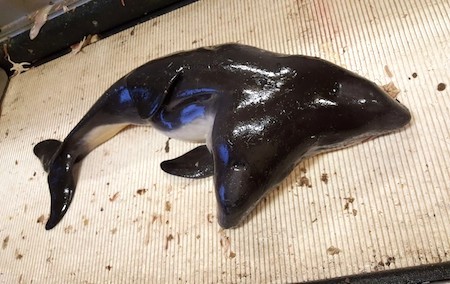
The Washington Post reports:
Dutch fishermen caught a rare two-headed sea creature. What happened next would horrify scientists.
A photo of the thing began to circulate through the Netherlands — eventually to the inbox of Erwin Kompanje, the curator of mammals at the Natural History Museum in Rotterdam, who was astounded.
He recalled his first thought: “Where??”
Where was it, and how soon could he get it into a lab?
Even today, in an age of science, it might appear to many people to be a two-headed sea monster.
Kompanje knew better, though the truth was no less astounding. He was looking at photos of two conjoined harbor porpoises, newborns sharing a single body, a rarity among rarities in all the oceans in the world….
For a researcher hungry for any morsel of information about man’s aquatic mammalian cousins, it was a one-in-a-billion discovery.
So Kompanje got the boss of the fishing crew on the phone, who was helpful — providing the exact coordinates and details of the catch…. And just then, on the phone with the trawler boss, he learned the true end of this strange tale.
“They thought it was illegal to collect it,” Kompanje said. “They made four photographs and threw it back into the sea. Back into oblivion….”
Kompanje and colleagues wrote a study about the two-headed dolphin. That study has been published in the biology journal Deinsea:
“The first case of conjoined twin harbour porpoises Phocoena phocoena (Mammalia, Cetacea),” Erwin J.O. Kompanje , C.J. (Kees) Camphuysen, and Mardik F. Leopold, Deinsea, June 7, 2017.
Deinsea is the same journal that in 2001 published Kees Moeliker’s Ig Nobel Prize-winning study “The First Case of Homosexual Necrophilia in the Mallard Anas platyrhynchos (Aves: Anatidae),” C.W. Moeliker, Deinsea, vol. 8, 2001, pp. 243-7.” Kees Moeliker and Erwin Kompanje and the world recently celebrated the 22nd Dead Duck Day, an event commemorating the incident of the duck.

Your Sensitivity to Smells, and the Size of Your Social Circle
The chant “Correlation Does Not Imply Causation” may come to mind when you read this report:
“What does the nose know? Olfactory function predicts social network size in human,” Lai-quan Zou, Zhuo-ya Yang, Yi Wang, Simon SY Lui, An-tao Chen, Eric FC Cheung, and Raymond CK Chan, Scientific Reports, vol. 6, 2016. The authors explain:
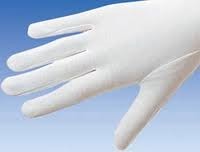 “it is not known whether olfactory function is associated with social network size. This study aimed to explore the underlying neural mechanism between olfactory function and social network. Thirty-one healthy individuals participated in this study. Social network size was estimated using the Social Network Index. Olfactory function was assessed with the Sniffin’ Stick Test. The results showed that there is a significant positive correlation between the size of an individual’s social network and their olfactory sensitivity”
“it is not known whether olfactory function is associated with social network size. This study aimed to explore the underlying neural mechanism between olfactory function and social network. Thirty-one healthy individuals participated in this study. Social network size was estimated using the Social Network Index. Olfactory function was assessed with the Sniffin’ Stick Test. The results showed that there is a significant positive correlation between the size of an individual’s social network and their olfactory sensitivity”

June 13, 2017
How Many Kids Can One Man Father in his Lifetime? [podcast]
The Improbable Research podcast begins life anew, with our new collaborator, Scientific American. Here’s the first new episode:
How Many Kids Can One Man Father in his Lifetime?
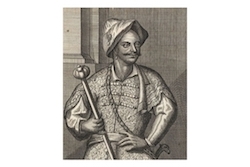
Every day was Father’s Day for Ismael the Bloodthirsty, the emperor of Morocco, who reportedly fathered 888 children. Ig Nobel Prize-winning biologist Lisa Oberzaucher tells why Moulay quite possibly had lots more than that. Recorded at Imperial College London.
PEOPLE IN THIS EPISODE
Elizabeth Oberzaucher, Ig Nobel Prize winner (mathematics, 2015), biologist based at the University of Vienna, Austria and at Ulm University, Germany.
Marc Abrahams, founder of the Ig Nobel Prize ceremony, and editor of the magazine Annals of Improbable Research
RELATED STUDY
“The Case of Moulay Ismael-Fact or Fancy?” Elisabeth Oberzaucher and Karl Grammer, PLOS ONE, vol. 9, no. 2, 2014, e85292.
PREVIOUS EPISODES: Dip into the pile of previous Improbable Research podcast episodes! Beginning with today’s episode we’ll be tossing some new formats into the mix.

June 12, 2017
The President’s Father and the Sneezing of Cats
Jean-Michel Macron is a neurologist who has published several studies about the sneezing of cats. His son is the current president of France.
Among Macron’s cat-sneeze studies:
Macron on Cat Sneezing (1991) — “Trigeminal afferences implied in the triggering or inhibition of sneezing in cats,” Fabrice Wallois, Jean Michel Macron, Vincent Jounieaux, and Bernard Duron, Neuroscience Letters, vol. 122, no. 2, 1991, pp. 145-147.
Macron on Cat Sneezing (1993) — “The sneeze: maturation of the reflex in kittens,” Fabrice Wallois, Jean-Michel Macron, Nicole Larnicol, and Dominique Rose, Neuroreport, vol. 4, no. 3, 1993, pp. 240-242. The authors report: “This is the first study to compare the influence of nasal afferent stimulation on inspiratory and expiratory muscle activity during sneezing, in kittens and adult cats.”
Macron on Cat Sneezing (1994) — “Influence of vagal afferents in the sneeze reflex in cats,” Jean-Michel Macron, Fabrice Wallois, and Bernard Duron, Neuroscience Letters, vol. 177, no. 1, 1994, pp. 79-82.
Macron on Cat Sneezing (1995) — “Activities of vagal receptors in the different phases of sneeze in cats,” Fabrice Wallois, Jean-Michel Macron, and Bernard Duron, Respiration Physiology, vol. 101, no. 3, 1995, pp. 239-255.
Here’s graphical data pertaining to a sneeze, from the 1994 paper:
For most of his career, Macron has been based at the Université de Picardie Jules-Verne. The Huffington Post published a report about Macron’s scientific exploits, including some of the cat sneeze research. We were unable to learn from that or any other source how many cats Macron owns at present, or whether he has any notable degree of allergy to cats.

Marc Abrahams's Blog
- Marc Abrahams's profile
- 14 followers



